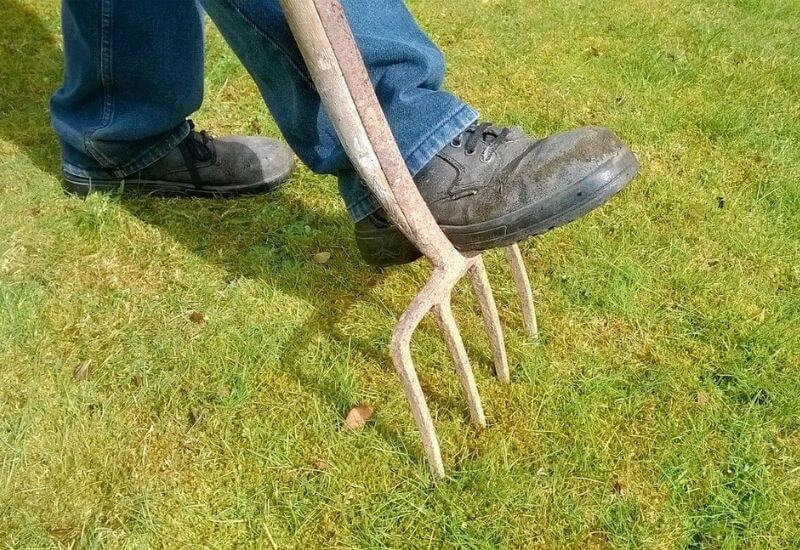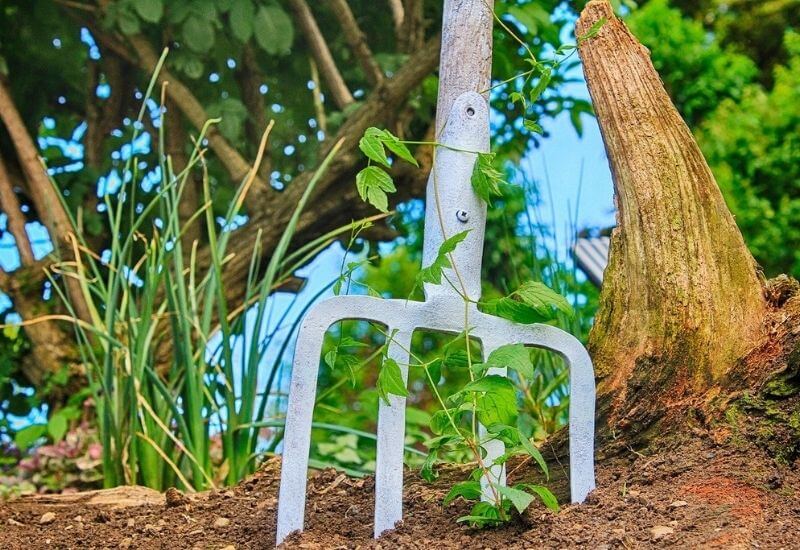Aerating your lawn is sometimes incredibly necessary if you want your lawn to be healthy. However, many people don’t know how to correctly aerate their lawns, and many others aren’t even sure of when it’s time to aerate their lawns in the first place.
Today, I want to share with you why aerating your lawn is so important and some tips you can use to help you effectively aerate your lawn.
Table of Contents
What Is Aeration, And Why Should You Do It?
Aerating your lawn just means perforating the surface of your lawn all over with small holes. This helps air, water, and other nutrients penetrate below the surface of the soil and make their way to the roots of your lawn in suitable quantities.
Aerating your lawn may be necessary to do every now and then because the soil under your lawn naturally becomes compacted over time.
The cause of this is usually equipment and vehicles driven around on your lawn, like riding mowers, for example, but it can also be caused by foot traffic, poor drainage, high content of clay in your soil, or a buildup of lawn thatch (a layer of mostly dead grass that accumulates between the leaves of grass on top and the roots and soil below).
If your lawn isn’t aerated properly, then the roots of your lawn can’t receive the nourishment they need to grow properly. This results in a lawn that appears thin and patchy, and the color of your grass may be noticeably less vibrant.
In general, there are three main types of aeration that are used:
- Spike aeration involves in which you simply poke holes into the soil with a spiky implement. Spike aeration is the easiest to do, although it’s not nearly as effective as other types of aeration.
- Core aeration involves using a machine with hollow tines to physically remove small plugs of soil and thatch from your lawn. The holes are usually 1/2″ to 3/4″ wide. Core aeration is generally the aeration method favored by lawn care professionals.
- Slicing aeration involves using a machine with spinning blades to slice down into the soil through the layer of grass and thatch. Slicing aeration can therefore be considered something of a compromise between spike aeration and core aeration since it creates more effective channels for air and water than spike aeration does, without displacing as much soil as core aeration does.
Each type of aeration has its own particular advantages and drawbacks. Spike aeration is potentially the most time-efficient method to use since there are numerous tools available for spike aeration, which make the process significantly easier; however, core aeration is better for your lawn overall.
How Do I Know If I Need to Aerate My Lawn?

In most cases, your lawn should be aerated at least once a year. Ideally, you want to aerate your lawn during the time where your lawn’s growth is at its peak. Aeration is good for your lawn in general, but aerating your lawn at the wrong time can actually damage it.
The time of year you should aerate your lawn depends on what kind of grass your lawn has. In the case of cool-season grasses, like ryegrass, bluegrass, or fescue that you tend to find in more northerly lawns, you’ll want to aerate them either in the early fall and early spring. For warm-season grasses that you typically find in more southern locations, like St. Augustine grass, Bermuda grass, or zoysiagrass, then you’ll want to perform your aeration either in the late spring or early summer.
However, there are a few circumstances in which your lawn might require some extra aeration, which are:
- If your lawn frequently gets a lot of foot traffic (for example, if your kids and pets often run around on your lawn or if you often host parties or other events on your lawn).
- If your lawn was established around the same time that your home was built (since your lawn was probably subject to lots of foot traffic due to the nearby construction).
- If your lawn has excessive amounts of thatch. A lawn in this condition will feel abnormally dry and spongy. To find out whether or not your lawn has a thatch problem, use a gardening shovel and remove a four-inch slice of earth to inspect the layer of thatch. If you can see that the thatch is thicker than about half an inch, you know your lawn will have to be aerated and probably dethatched too.
- If your lawn was established by sod. When you lay down sod, the soil that comes with sod is usually significantly finer in texture than the existing soil underneath. Because fine soil can retain more water, water gets trapped in the upper layer of soil and isn’t able to drain properly. This leads to soil that is heavily compacted, and it can also prevent the roots of your lawn from developing properly.
How To Aerate Your Lawn
Now that you’re familiar with why and when to aerate your lawn let’s go over how it’s actually done. If you don’t care to do it yourself, you can easily hire a lawn care service to do it for you, but it’s really not that hard to do it yourself, especially if your lawn isn’t very large; there are just a few things to keep in mind to ensure that you aerate your lawn correctly.
- For starters, it’s best to make sure your soil is somewhat moist before aerating your lawn. Soil that is too dry and hard will be very difficult to aerate properly, so consider watering your lawn the day before you perform the aeration or aerating your lawn the day after a rainstorm. However, you don’t want to aerate your lawn if it’s too wet and muddy.
- It’s also a good idea to trim your lawn before aerating it. You may also want to remove any leaves or other debris from your lawn beforehand and mark the locations of any underground sprinklers on your property (if you have any).
- Then, you can actually get started on the process of aerating your lawn. You can use whatever tool you want to complete this task. It’s best to figure out beforehand which areas on your lawn are the most compacted and target those areas specifically; you’ll save time and energy that way.
- Also, you’ll probably have to run your aeration tools multiple times over the same area since most of these tools don’t actually affect that much of the soil’s surface area with each pass you make. This is why it’s a good idea to not work on too large of an area at once.
- If you’re using core aeration, you should leave the excavated plugs of soil on your lawn after removing them. Then after they’ve dried, break them up with a lawnmower or rake. Doing so will allow your lawn to re-absorb any nutrients in the soil that were originally removed along with the plugs.
- After aerating your lawn, you should do your best to maintain a regular schedule of mowing, watering, and fertilizing your lawn.
The Best Aeration Tools
Now, let’s talk about some handy tools you can use to help aerate your lawn. We’ll be going over a range of manual and power-operated tools that can make aerating your lawn a lot easier.
Aerator shoes make aerating your lawn literally as easy as just walking around on it. These “shoes” are really just spiked soles that you can strap on over shoes or work boots.
Aerator shoes are a really neat tool because they allow you to use your lawn care time more efficiently; for example, you can wear them while mowing your lawn and essentially do two tasks at once.
This aerating tool is a simple yet effective one. It consists of two 1/2″-wide hollow tines at the end of a handle. Using it as a shovel, you can dig into your lawn and remove two plugs of soil at a time.
This tool’s downside is that it may take you longer to aerate your lawn using it that it would with other tools since it really can’t cover all that much surface area at once.
Another solid option for manually aerating your lawn, this push spike aerator resembles a manual push mower but with a rotating bladed barrel instead of mower blades.
This particular push aerator comes with an area on top designed to hold a concrete block designed to push the aerator’s spikes further into the ground and enhance its effectiveness.
Electric Scarifier and Dethatcher
If your lawn is being affected by excessive amounts of thatch, you may need an electric dethatcher. This machine resembles an electric push mower, but instead of mower blades, it features a spinning barrel fitted with spikes designed to aerate your lawn as well as remove any thatch that might be accumulating under your grass.
If you have a large enough lawn that necessitates the use of a riding mower, you would probably find a tow aerator to be the most useful. Tow aerators resemble push aerators in basic design, except they’re generally larger and designed to be pulled behind a riding mower instead of pushed in front of you.
You can find both tow spike aerators and tow core aerators like this one here.
Conclusion
Aerating your lawn can be a challenging process, but it doesn’t have to be. With the right knowledge and tools, you should have no problem aerating your lawn correctly and getting it into the best shape possible.
I hope the tips and tools I’ve suggested today help make aerating your lawn a simple task. Good luck with your lawn care!






